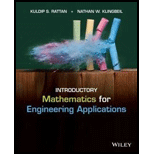
An actuator used in a prosthetic arm can produce different amounts of force by changing the voltage of the power supply. The force and voltage satisfy the linear relation
(a) Find the force produced by the actuator when supplied with 6.0 V.
(b) What voltage is needed to achieve force of 5.0 N?
(c) Using the results of par1 (a) and (b), sketch the graph of F as a function of voltages V. Use the appropriate scales and clearly label the slope and the results of parts (a) and (h).
Want to see the full answer?
Check out a sample textbook solution
Chapter 1 Solutions
Introductory Mathematics for Engineering Applications
Additional Math Textbook Solutions
Advanced Engineering Mathematics
Fundamentals of Differential Equations (9th Edition)
Basic Technical Mathematics
College Algebra (7th Edition)
College Algebra
Glencoe Math Accelerated, Student Edition
 Trigonometry (MindTap Course List)TrigonometryISBN:9781305652224Author:Charles P. McKeague, Mark D. TurnerPublisher:Cengage LearningAlgebra & Trigonometry with Analytic GeometryAlgebraISBN:9781133382119Author:SwokowskiPublisher:Cengage
Trigonometry (MindTap Course List)TrigonometryISBN:9781305652224Author:Charles P. McKeague, Mark D. TurnerPublisher:Cengage LearningAlgebra & Trigonometry with Analytic GeometryAlgebraISBN:9781133382119Author:SwokowskiPublisher:Cengage Functions and Change: A Modeling Approach to Coll...AlgebraISBN:9781337111348Author:Bruce Crauder, Benny Evans, Alan NoellPublisher:Cengage Learning
Functions and Change: A Modeling Approach to Coll...AlgebraISBN:9781337111348Author:Bruce Crauder, Benny Evans, Alan NoellPublisher:Cengage Learning


